Fried Egg Jellyfish Are Kind Of Adorable – & That’s No Yolk.
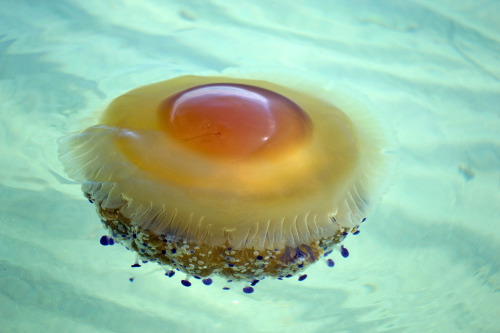

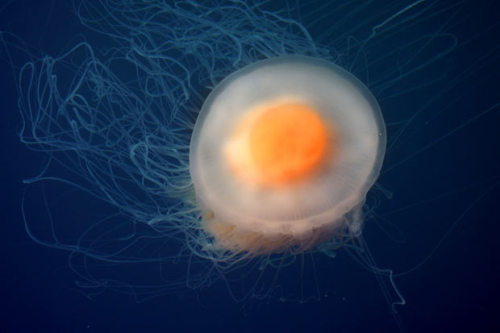
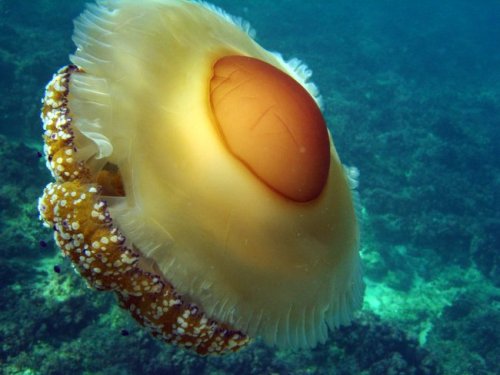
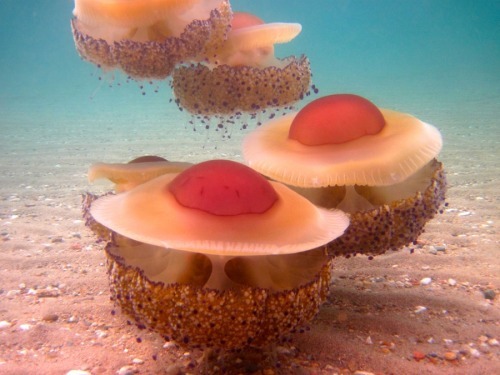
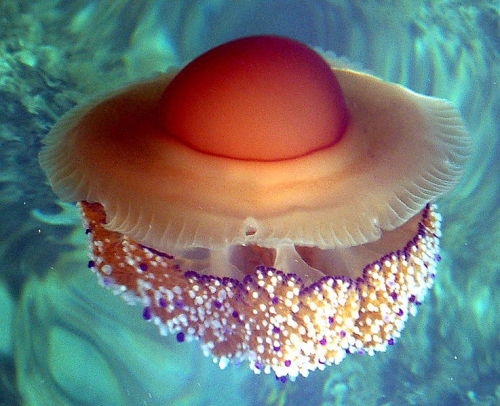
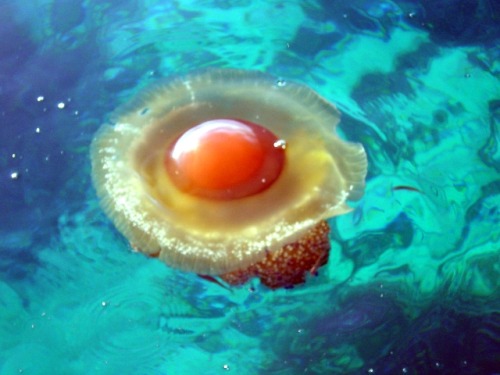
Fried Egg Jellyfish Are Kind of Adorable – & That’s No Yolk.
There are two species that hold the whimsical title of “Fried Egg Jellyfish”: Phacellophora camtschatica and Cotylorhiza tuberculata though the two are quite different from each other in all aspects beside appearance.
Phacellophora camtschatica is a huge jelly that prefers colder waters. It’s bell can reach up to 2 ft across and its dozens of tentacles reach over 20 ft long! If you don’t think this floating egg creature looks very menacing, you’d be right. It has a very weak sting and many small crustaceans take advantage of the jelly by riding on its bell (breakfast to go…?) while snatching up extra food.
Cotylorhiza tuberculata is a much smaller jellyfish that hangs out in warmer waters. It only reaches about 35 cm in diameter, so don’t go for this Fried Egg Jelly if you want a big breakfast. Unlike most jellyfish, C. tuberculata can swim on its own, without relying on the currents for movement. It’s sting (if you can even call it that) is so feeble that it has very little to no effect on humans at all. I mean, it does look like a breakfast food, after all… how powerful could it be?
More Posts from Simplyphytoplankton and Others

This Type of Algae Absorbs More Light for Photosynthesis Than Other Plants
An obscure and ecologically successful group of algae, known as cryptophytes, have evolved pigments that capture light where chlorophyll cannot, Dudycha and colleagues report in a series of recent papers. The extra energy absorption from more wavelengths of light has allowed these algae to thrive in a variety of diverse environments, from oceans to streams to ponds to mud puddles.

#4—Fun Facts for World Whale Day
Whales are the biggest creatures to ever live on the earth. The largest whale, the blue whale, can be over 90 feet long. The sperm whale, on the other hand, may not be the biggest whale, but it has the biggest brain to have ever existed on Earth.
Learn more about how whales grew to such massive sizes here.
Photo: Smithsonian Institution
More on phytoplankton to come soon! Check out my first introductory post if you missed it.

Phytoplankton: An overview of the small, plant-like organisms that make the world go round.
http://becausephytoplankton.blogspot.com/2017/11/what-are-phytoplankton.html?spref=tw
Image Credit: NASA/Goddard/Aqua/MODIS via Flickr

From Kane Lynch and our stats dept.

For two years, the Bering Sea has been largely without winter ice, a development scientists modeling the warming impacts of greenhouse-gas pollution from fossil fuels once forecast would not occur until 2050.
This ice provided a giant platform for growing algae at the base of the food chain, and has been a significant contributor to the remarkable productivity of a body of water, stretching from Alaska to northeast Russia, that sustains some of the biggest fisheries on the planet.




It’s the biologists turn
Having recently shared images from the Nikon Small World (see http://bit.ly/2xQdOHd) and the Insight Astronomy Photographer of the Year 2017 awards (see http://bit.ly/2ipNvkn), here are some photos from the Royal Society of Biology’s 2017 Photographer of the Year and Young Photographer of the Year competitions in a week of the year that seems to have all these events announcing their honours more or less simultaneously.
Keep reading
Phytoplankton
The word phytoplanton comes from the greek words phyto (plant) plankton (made to wander) And what they do for the world is amazing! They are a great example of doing SO much even though they are small. Without them we wouldn’t have enough oxygen. The fish and sea life would all most definately die, which would effect food for humans and land animals. It would effect cultures and peace in general, because without sea life many beliefs and practices would be effected as well. Without them the sea animals wouldn’t be able to “breathe”. A good way humans can make sure to keep the phytoplankton around is by making sure we don’t litter, or pour harmful chemicals into the ocean that could kill them. A great place to learn more about this is here:
http://earthobservatory.nasa.gov/Features/Phytoplankton/
http://save-as.org/GreenNews/News/phytoplankton-the-oceans-vital-force-is-dying-out_1675
http://www.savethesea.org/plankton.html





When wood turns into glitter
Many moons ago, in the area that is now Nevada ancient woodlands were living through events that would result in some stunning pieces that grace museums around the world. Some 14 million years ago in the Miocene, the area was thickly forested rather than displaying the arid environment of today. It was also much closer to sea level, since the area has been extensively uplifted since then, due to tectonic stresses caused by the subduction of the Pacific and Farallon plates under the North American one. The area also saw intense subduction related volcanism (ongoing along the USA’s west coast to this day), which periodically covered the forests in silica rich ash. As groundwater interacted with the magma below, weathering the layers of ash into clays, it dissolved silica, precipitating it when conditions such as temperature and pressure changed, replacing the ash covered trees with opal, sometimes so clearly that every cell is visible. While not really suitable for jewellery use due to its tendency to crack as it dries out (called crazing in the trade), these rare logs from the Virgin Valley of Nevada make for stunning collector’s specimens
Keep reading

Prionace glauca by migueldesigns It’s no exaggeration to say the blue shark is one of the most beautiful sharks swimming in the earth’s waters today. It stands out with its slim, elongated, torpedo-shaped body and beautiful swimming style. Sadly, this shark species is among the most highly fished sharks around. Humans catch it for its fins, meat, oil, and as a display animal because of its beauty. About 10 million blue sharks are killed by humans every year! As a result, this shark is listed as Near Threatened by the IUCN. Blue sharks have a deep blue back with white underbelly, large eyes, and long pectoral fins. It has a particularly strong and unique sense of smell.
Every once in a while, sanctuary researchers get a treat – like getting to see this tiny baby octopus! 🐙 .
Each summer, researchers conduct expeditions in our West Coast sanctuaries as part of the ACCESS conservation partnership. Researchers get to see creatures big and small when conducting surveys in places like Greater Farallones National Marine Sanctuary!
-
 squaggleson liked this · 1 month ago
squaggleson liked this · 1 month ago -
 ihavemace reblogged this · 2 months ago
ihavemace reblogged this · 2 months ago -
 cafeselection reblogged this · 3 months ago
cafeselection reblogged this · 3 months ago -
 ladyzsgolla liked this · 3 months ago
ladyzsgolla liked this · 3 months ago -
 theseniorlibrarypage reblogged this · 3 months ago
theseniorlibrarypage reblogged this · 3 months ago -
 hexandjex liked this · 3 months ago
hexandjex liked this · 3 months ago -
 haliotis94 liked this · 5 months ago
haliotis94 liked this · 5 months ago -
 a-cosmonaut-or-an-astronaut liked this · 6 months ago
a-cosmonaut-or-an-astronaut liked this · 6 months ago -
 lightningscarecrow77 liked this · 7 months ago
lightningscarecrow77 liked this · 7 months ago -
 waltzing-marionettes reblogged this · 9 months ago
waltzing-marionettes reblogged this · 9 months ago -
 waltzing-marionettes liked this · 9 months ago
waltzing-marionettes liked this · 9 months ago -
 cirrusskyanimations liked this · 1 year ago
cirrusskyanimations liked this · 1 year ago -
 fastofthekillones liked this · 1 year ago
fastofthekillones liked this · 1 year ago -
 stars-blogspot reblogged this · 1 year ago
stars-blogspot reblogged this · 1 year ago -
 cohesin liked this · 1 year ago
cohesin liked this · 1 year ago -
 siterlas reblogged this · 1 year ago
siterlas reblogged this · 1 year ago -
 huomenhaamu liked this · 2 years ago
huomenhaamu liked this · 2 years ago -
 ghost-flores liked this · 2 years ago
ghost-flores liked this · 2 years ago -
 scarlettrust reblogged this · 2 years ago
scarlettrust reblogged this · 2 years ago -
 scarlettrust liked this · 2 years ago
scarlettrust liked this · 2 years ago -
 lauraatulsa reblogged this · 2 years ago
lauraatulsa reblogged this · 2 years ago -
 lauraatulsa liked this · 2 years ago
lauraatulsa liked this · 2 years ago -
 wildernestt reblogged this · 2 years ago
wildernestt reblogged this · 2 years ago -
 fuckincuteassanimals reblogged this · 2 years ago
fuckincuteassanimals reblogged this · 2 years ago -
 waterloggedgarden liked this · 2 years ago
waterloggedgarden liked this · 2 years ago -
 addictedddoodler liked this · 2 years ago
addictedddoodler liked this · 2 years ago -
 mirrorforcez reblogged this · 2 years ago
mirrorforcez reblogged this · 2 years ago -
 mirrorforces liked this · 2 years ago
mirrorforces liked this · 2 years ago -
 intothevrains reblogged this · 2 years ago
intothevrains reblogged this · 2 years ago -
 intothevrains liked this · 2 years ago
intothevrains liked this · 2 years ago -
 downwardslopeofreallynothing reblogged this · 2 years ago
downwardslopeofreallynothing reblogged this · 2 years ago -
 space-kase liked this · 2 years ago
space-kase liked this · 2 years ago -
 ancona-best-porto liked this · 2 years ago
ancona-best-porto liked this · 2 years ago -
 crystalfoxflower liked this · 2 years ago
crystalfoxflower liked this · 2 years ago -
 silenthilllz reblogged this · 2 years ago
silenthilllz reblogged this · 2 years ago -
 wildernestt liked this · 3 years ago
wildernestt liked this · 3 years ago -
 glinnmelethril reblogged this · 3 years ago
glinnmelethril reblogged this · 3 years ago -
 glinnmelethril liked this · 3 years ago
glinnmelethril liked this · 3 years ago -
 when-ifallandhitthe-ground liked this · 3 years ago
when-ifallandhitthe-ground liked this · 3 years ago -
 wings-and-cherry-blossoms liked this · 3 years ago
wings-and-cherry-blossoms liked this · 3 years ago -
 ihadsometimealone reblogged this · 3 years ago
ihadsometimealone reblogged this · 3 years ago -
 themagicaltunaa reblogged this · 3 years ago
themagicaltunaa reblogged this · 3 years ago -
 thesoulfirerevolution liked this · 3 years ago
thesoulfirerevolution liked this · 3 years ago -
 murderthegods liked this · 3 years ago
murderthegods liked this · 3 years ago -
 rainbowpeach123 reblogged this · 3 years ago
rainbowpeach123 reblogged this · 3 years ago -
 rainbowpeach123 liked this · 3 years ago
rainbowpeach123 liked this · 3 years ago

Blog dedicted to phytoplankton. Phytoplankton are microscopic organisms that are responsible for half of the photosynthesis that occurs on Earth. Oh, and they look like art... Follow to learn more about these amazing litter critters! Caution: Will share other ocean science posts!Run by an oceanographer and phytoplankton expert. Currently a postdoctoral researcher.Profile image: False Colored SEM image of Emiliania huxleyi, a coccolithophore, and the subject of my doctoral work. Credit: Steve Gschmeissner/ Science Photo Library/ Getty ImagesHeader image: Satellite image of a phytoplankton bloom off the Alaskan Coast, in the Chukchi SeaCredit: NASA image by Norman Kuring/NASA's Ocean Color Web https://earthobservatory.nasa.gov/images/92412/churning-in-the-chukchi-sea
158 posts